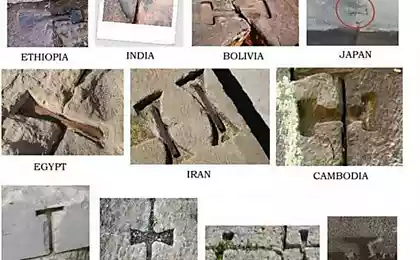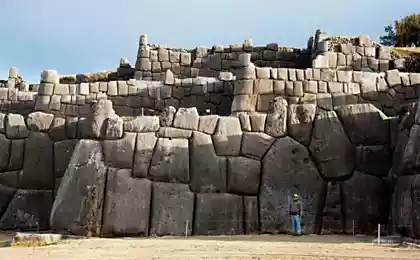264
Ten incredible ancient technologies that are considered advanced even in our time

This article provides vivid examples of advanced ancient technologies ahead of time. Some of these complex inventions were later rediscovered in the modern era, but not all. There is no doubt that our ancestors had perfect knowledge in various fields.
Did ancient Peruvians soften stones?
Sacsayhuaman - citadel on the northern outskirts of the city of Cusco, the ancient capital of the Incas in Peru
Archaeologists and scientists are scratching their heads over conjectures about how the mysterious Sacsayhuaman structure in Peru was built.
The giant stones from which this unusual ancient fortress was built are so heavy that it would be difficult to transport and install them even with the help of modern technology.
Is the key to solving this mystery in the special equipment that the ancient Peruvians used to soften stone blocks, or is it all a secret ancient technology of melting stones?
According to some researchers, the granite from which the walls of the fortress in Cusco were built was exposed to very high temperatures, so its outer surface became glassy and smooth.
The scientists concluded that the stones were softened with some high-tech equipment, and then each block was polished according to the cutouts of the neighboring stone, which is why they fit so tightly together.
Sound effects Hal Saflieni Hypogeum - an example of a collective, primitive rock tomb
The Hal Saflieni Hypogeum Sanctuary in Malta is famous for its striking acoustics. Hal Saflieni is an underground cave system with an area of about 500 meters, located on three tiers. Corridors and passageways lead to small rooms that date back to 3000-2500 BC. The cave system was discovered in 1902 and the "Oracle Room" immediately attracted attention. In this stone room you can hear incredible sound effects that have a certain effect on the human body. The sounds that you hear in this room resonate all over the room, and then they kind of pierce through the human body.
The Hal Saflieni Hypogeum has a dark history. Researchers found the remains of more than 7,000 people on its territory, as well as many deep pits, crevices and even burial chambers. What experiments have been conducted in this strange and mysterious place?
Lycurgus Cup: an interesting artifact testifying to the knowledge of ancient nanotechnology
This amazing artifact proves that our ancestors were ahead of their time. The technique of making the cup is so perfect that its masters were already familiar with what we today call nanotechnology.
This unusual and unique bowl, made of dichroic glass, is able to change its color depending on the lighting - for example, from green to bright red. This unusual effect occurs because the dichroic glass contains a small amount of colloidal gold and silver.
Ancient Baghdad batteries in Baghdad
Scientists suggest that this small and unremarkable artifact is an example of a source of electricity in the ancient world. We are talking about the so-called Baghdad battery of the Parthian period.
The electric battery, made about 2,000 years ago, was discovered in 1936 by railway workers in the Kujut Rabu district near Baghdad.
It is believed that the world’s first known electric battery, the Volts Pillar, was invented by the Italian physicist Alessandro Volt only in 1799, while most sources indicate that the origin of the Baghdad battery dates back to about 200 BC.
The column in India is 98% pure iron of very high quality. It is believed that the column was cast from a single piece of iron.
It is quite possible that in ancient times, people possessed not only 21st century technologies, but also the kind of knowledge that we are still striving for.
High-tech methods of hardening and processing large pieces of metal were widespread already in ancient times. Our ancestors had extremely sophisticated scientific knowledge of metalworking, which they inherited from earlier civilizations, as evidenced by artifacts found around the world.
Metallurgical technologies were known even in ancient China, and it was one of the first civilizations to make pig iron.
In ancient India, they were able to produce iron, which was not subjected to rust due to its high phosphorus content. One of these iron columns, 7 meters high and weighing about 6 tons, is installed in front of the Qutb Minar minaret in Delhi, India.
In stones (even the hardest) drilled holes for architectural, ritual or symbolic purposes.
Evidence of this incredible technology, widespread in antiquity, can be found all over the world. Already in ancient times, builders could make perfectly round holes in stones and hard rocks.
This impressive technique of drilling stones testifies to the fact that our ancestors were familiar with the most complex technologies – the creation of such large holes is impossible without engineering skills and the necessary drilling equipment.
Legendary “Sunstones” of the Vikings helped them navigate the seas During the time of the Vikings, the magical “Sunstone” helped sailors find their way in the absence of the sun
In the sagas of the Norwegian Vikings, there are references to the mysterious and magical "Sunstone", with which sailors could determine the position of the sun.
In the fairy tales of St. Olaf, the Viking King, along with other magical objects, some mysterious crystals are mentioned, so the possibility of the existence of these stones has long been in doubt.
However, when archaeologists discovered this unusual crystal, it became clear that the legendary Viking stones actually existed.
Ancient and sophisticated mercury-based gilding techniques that modern technology has not yet achieved Most gilding and silvering techniques were used for decoration, although sometimes they were used to deceptively give the appearance of gold or silver to less valuable items.
Already in ancient times, jewelers working with silver and gold used mercury to gild domes and interiors in many countries of the ancient world.
These complex processes were used to produce and coat products such as jewelry, figurines, and amulets.
Although gilding and silver techniques were most often used for decoration, they were sometimes used to deceptively give the appearance of gold or silver to less valuable items.
From a technological point of view, the ancient craftsmen managed to make these metal coatings incredibly thin and durable 2,000 years ago, saving precious metals and improving their durability.
Recent discoveries testify to the high level of competence of ancient artisans who were able to produce objects of a quality that could not be surpassed in those days, and which even modern technology has not yet achieved.
Ancient computer: the mysterious mechanism from Antikythera is still full of mysteries Researchers have long argued where and by whom this device was built
In 1900, near the small island of Antikythera, 25 miles northwest of Crete, an unusual bronze object of unknown purpose was discovered. After curious scientists pulled this artifact out of the water and cleared it, they found parts of some complex mechanism consisting of different gears.
The perfectly flat discs of this mechanism and some of the traces of inscriptions found are likely to correspond to its basic function.
Most likely, the mechanism is an astronomical clock without a pendulum, however, in both Greek and Roman literature, no mention of this ancient computer is found. The artifact was discovered next to a ship that sunk presumably in the 1st century BC.
There are many examples of robots created in ancient China
In ancient China, there were highly developed robots that could sing, dance, act as servants and perform other complex tasks.
Some of these impressive robots consisted of elements similar to human organs – bones, muscles, joints, skin and hair.
A remarkable fact, considering that only recently modern civilization invented humanoid robots. This indicates that in ancient China engineering and mechanics reached a very high level of development.
published
P.S. And remember, just by changing your consciousness – together we change the world!
Source: mixstuff.ru/archives/87638
10 exciting facts about cat's tail
Twenty years ago, pediatricians and child psychologists have attempted to say that his kids something is amiss























